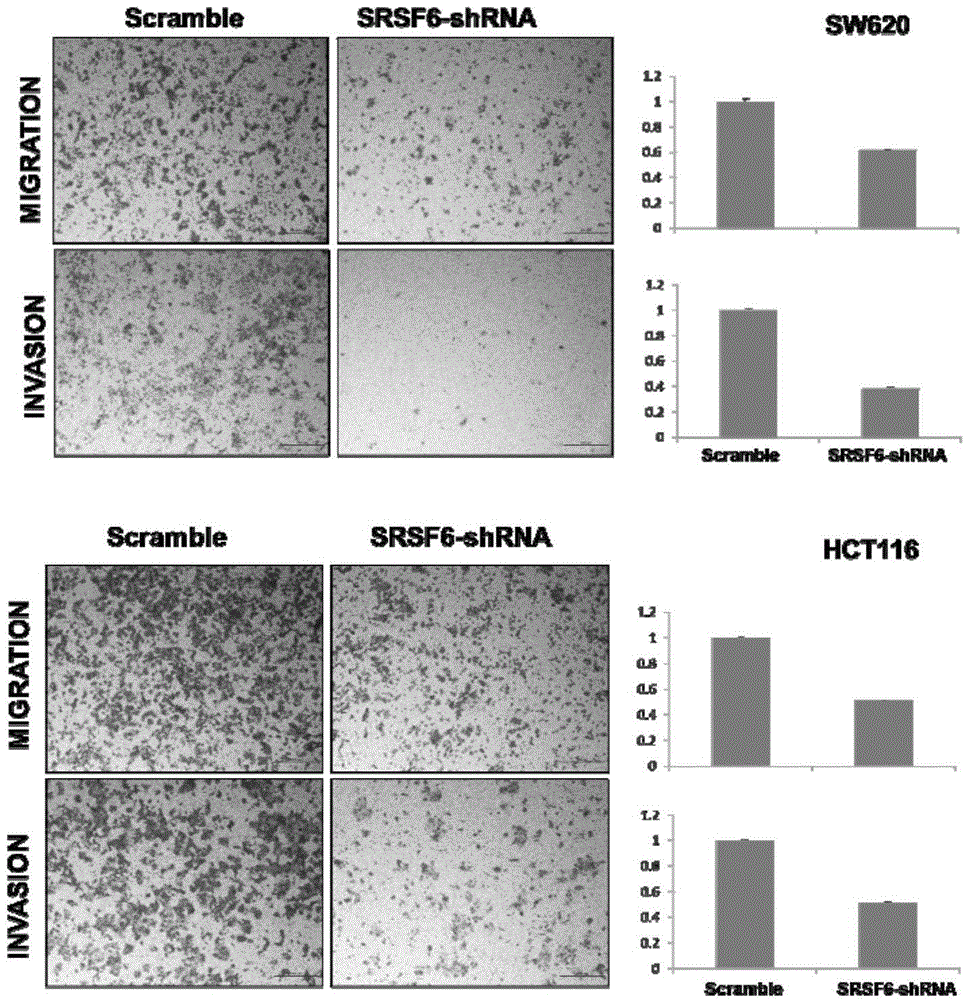Construction of SRSF6-targeting lentivirus interference vector and applications of SRSF6-targeting lentivirus interference vector in colorectal cancer treatment
A lentiviral, colorectal technology applied in the field of molecular biology
- Summary
- Abstract
- Description
- Claims
- Application Information
AI Technical Summary
Problems solved by technology
Method used
Image
Examples
Embodiment 1
[0033] Example 1 Construction and verification of SRSFR6-shRNA interference vector
[0034] Materials and methods
[0035] 1. Materials
[0036]Colorectal cancer cell lines SW620, HT29, HCT116 and lentiviral packaging cell line HEK293T were provided by the Institute of Biochemistry and Cell Biology, Chinese Academy of Sciences; RPMI1640, DMEM, 0.05% Trypsin were purchased from Boster; fetal bovine serum was purchased from Siji Green Company. SRSF6 antibody was purchased from SIGMA; ACTIN antibody was purchased from CST; Lipo2000 transfection reagent and puromycin were purchased from Invitrogen; Age I, EcoR I endonuclease and T4 DNA ligase were purchased from TaKaRa. Escherichia coli DH5α, PLKO.1, psPAX2, and pMD2.G vectors were all preserved in our laboratory; primers were entrusted to Shanghai Sunny Co., Ltd. to synthesize; plasmid extraction kits were purchased from QIGEN; other drugs were of domestic analytical grade.
[0037] 2. Method
[0038] 2.1. Design of shRNA seq...
Embodiment 2
[0064] Example 2 Inhibition of the proliferation ability of colorectal cancer cells by SRSFR6-shRNA
[0065] Materials and methods
[0066] 1. Materials
[0067] Colorectal cancer cell lines SW620, HT29, and HCT116 were provided by the Institute of Biochemistry and Cell Biology, Chinese Academy of Sciences. RPMI1640, DMEM, 0.05% Trypsin, and CCK8 reagents were purchased from Boster; fetal bovine serum was purchased from Sijiqing Company. Puromycin was purchased from Invitrogen. Other medicines were domestic analytically pure.
[0068] 2. Method
[0069] 2.1 Take SW620 as an example for the screened stable cell line, count 5*10^5 cells and spread them on two wells of a six-well plate. At this time, the medium is free of puromycin
[0070] 2.2 About two days later, lay a 96-well plate for CCK8 proliferation experiment.
[0071] 1) Digest the cells of SW620‐SRSF6‐shRNA group and SW620‐scramble group with trypsin, collect the cells, and count them so that the final concentra...
Embodiment 3
[0076] Example 3 Inhibition of SRSFR6-shRNA on migration and invasion of colorectal cancer cells
[0077] Materials and methods
[0078] 1. Materials
[0079] Colorectal cancer cell lines SW620, HT29, and HCT116 were provided by the Institute of Biochemistry and Cell Biology, Chinese Academy of Sciences. RPMI1640, DMEM, 0.05% Trypsin, reagents were purchased from Boster Company; fetal bovine serum was purchased from Sijiqing Company. Puromycin was purchased from Invitrogen. Transwell double-layer board was purchased from COSTAR Company, Matrigel glue was purchased from BD Company, and crystal violet was purchased from Biyuntian Company. Other medicines were domestic analytically pure.
[0080] 2. Method
[0081] 2.1 Take SW620 as an example of the screened stably transfected cell line, count 5*10^5 cells and spread them on two wells of a six-well plate. At this time, the medium is free of puromycin.
[0082] 2.2 After about two days, spread the Transwell chamber.
[008...
PUM
 Login to View More
Login to View More Abstract
Description
Claims
Application Information
 Login to View More
Login to View More - R&D
- Intellectual Property
- Life Sciences
- Materials
- Tech Scout
- Unparalleled Data Quality
- Higher Quality Content
- 60% Fewer Hallucinations
Browse by: Latest US Patents, China's latest patents, Technical Efficacy Thesaurus, Application Domain, Technology Topic, Popular Technical Reports.
© 2025 PatSnap. All rights reserved.Legal|Privacy policy|Modern Slavery Act Transparency Statement|Sitemap|About US| Contact US: help@patsnap.com



